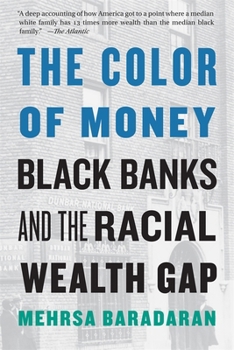The Color of Money: Black Banks and the Racial Wealth Gap
Select Format
Select Condition 
Book Overview
"Read this book. It explains so much about the moment...Beautiful, heartbreaking work."
--Ta-Nehisi Coates
--The Atlantic "Extraordinary...Baradaran focuses on a part of the American story that's often ignored: the way African Americans were locked out of the financial engines that create wealth in America."
--Ezra Klein When the Emancipation Proclamation was signed in 1863, the black community owned less than 1 percent of the total wealth in America. More than 150 years later, that number has barely budged. The Color of Money seeks to explain the stubborn persistence of this racial wealth gap by focusing on the generators of wealth in the black community: black banks. With the civil rights movement in full swing, President Nixon promoted "black capitalism," a plan to support black banks and minority-owned businesses. But the catch-22 of black banking is that the very institutions needed to help communities escape the deep poverty caused by discrimination and segregation inevitably became victims of that same poverty. In this timely and eye-opening account, Baradaran challenges the long-standing belief that black communities could ever really hope to accumulate wealth in a segregated economy. "Black capitalism has not improved the economic lives of black people, and Baradaran deftly explains the reasons why."
--Los Angeles Review of Books "A must read for anyone interested in closing America's racial wealth gap."
--Black Perspectives
Format:Paperback
Language:English
ISBN:0674237471
ISBN13:9780674237476
Release Date:March 2019
Publisher:Belknap Press
Length:384 Pages
Weight:0.86 lbs.
Dimensions:1.2" x 5.4" x 8.2"
Customer Reviews
1 rating
The Color of Money Black Banks and the Racial Wealth Gap is uncompromising with it's lessons
Published by Patrick McCarthy , 2 years ago
An outstandingly researched and well written account of how the powerful white supremacist banking industry developed, while systematically under developing black banks. The author Mehrsa Baradaran spares no words in giving a full account of the development of the banking industry on the backs of people of color, particularly the black working class and what lead to what still exists today, underdeveloped black communities, gentrification, redlining, racism and white wealth gap which continues to expand. The Color of Money offers many insights to people of color on how to better understand their economic position in society, how it came to be and the challenges they come up against in trying to change the landscape, improve their quality of life and reduce the racial wealth gap, which continues to expand at an even more rapid pace today.






